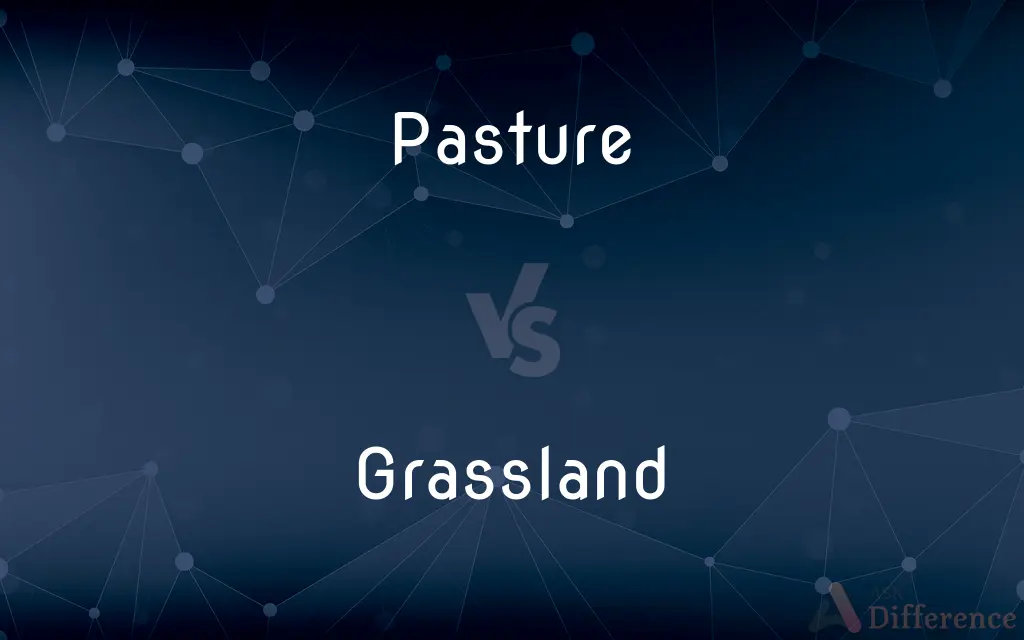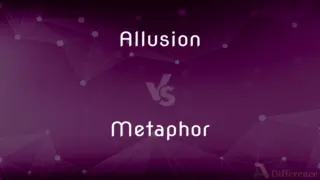Pasture vs. Grassland — What's the Difference?
Edited by Tayyaba Rehman — By Maham Liaqat — Updated on March 1, 2024
Pastures are managed lands used for grazing livestock, while grasslands are natural ecosystems dominated by grasses.

Difference Between Pasture and Grassland
Table of Contents
ADVERTISEMENT
Key Differences
Pasture refers to land covered with grass or other plants used for grazing animals. It is often managed and maintained by humans to enhance feed quality and availability. Whereas grasslands are vast areas of natural land dominated by grasses and other herbaceous plants, they can be found in many climates and are not primarily managed for livestock grazing.
Pastures are typically smaller and more controlled environments, often enclosed and improved through seeding, fertilizing, and mowing. On the other hand, grasslands encompass larger ecosystems such as prairies, savannas, and steppes, which maintain their state through natural processes and can support a wide range of wildlife.
Pastures are utilized for the specific purpose of feeding domesticated animals, grasslands play a crucial role in biodiversity, supporting various species of plants and animals. Grasslands also contribute significantly to soil conservation and carbon sequestration.
Irrigation and fertilization are common in pastures to ensure a consistent supply of high-quality forage for livestock. Conversely, grasslands rely on natural rainfall patterns and are adapted to local soil and climatic conditions, often surviving in areas with limited agricultural value.
Management practices in pastures aim at optimizing conditions for specific livestock needs, including rotational grazing to prevent overgrazing. Grasslands, however, are subject to natural grazing patterns by wild animals, which help maintain ecological balance without human intervention.
ADVERTISEMENT
Comparison Chart
Definition
Land managed for grazing animals.
Natural ecosystems dominated by grasses.
Management
Actively managed through seeding, fertilizing, and mowing.
Minimal human management, maintained through natural processes.
Purpose
To provide feed for domesticated livestock.
To support biodiversity and ecological balance.
Size and Control
Typically smaller, enclosed areas.
Larger, open ecosystems.
Environmental Role
Feed production for livestock.
Biodiversity conservation, soil protection, carbon sequestration.
Compare with Definitions
Pasture
A managed ecosystem for domesticated animals.
The pasture management plan included rotational grazing.
Grassland
A large open area of country covered with grass. especially one used for grazing.
Bison roamed the vast grasslands.
Pasture
An area seeded with specific grasses for grazing.
We seeded the pasture with clover to improve nutrition.
Grassland
Natural ecosystems dominated by grasses.
The prairie is a type of grassland that supports a variety of wildlife.
Pasture
Managed land for feeding livestock.
The farmer rotated his livestock to allow the pasture to regenerate.
Grassland
Areas where the vegetation is predominantly grass.
The African savannas are grasslands with diverse species.
Pasture
Land covered with grass and other low plants suitable for grazing animals.
The cows grazed peacefully in the lush pasture.
Grassland
Ecosystems maintained through natural processes.
Fire plays a crucial role in the health of certain grasslands.
Pasture
An enclosed area with grass for animals.
The horses were moved to a new pasture for fresh grass.
Grassland
Land that supports a wide range of plant and animal life.
Grasslands are important for conservation efforts.
Pasture
Pasture (from the Latin pastus, past participle of pascere, "to feed") is land used for grazing. Pasture lands in the narrow sense are enclosed tracts of farmland, grazed by domesticated livestock, such as horses, cattle, sheep, or swine.
Grassland
Grasslands are areas where the vegetation is dominated by grasses (Poaceae). However, sedge (Cyperaceae) and rush (Juncaceae) can also be found along with variable proportions of legumes, like clover, and other herbs.
Pasture
Land covered with grass and other low plants suitable for grazing animals, especially cattle or sheep
Areas of rich meadow pasture
Grassy pastures
Many a horse was put out to pasture there
A range of pasture grasses
Grassland
An area, such as a prairie or meadow, of grass or grasslike vegetation.
Pasture
Used to refer to a person's situation in life
She left the office for pastures new
Grassland
An area dominated by grass or grasslike vegetation.
Pasture
A tract of land that supports grass or other vegetation eaten by domestic grazing animals.
Grassland
Land where grass or grasslike vegetation grows and is the dominant form of plant life
Pasture
To herd (animals) into a pasture to graze.
Pasture
To feed on growing grass; to graze.
Pasture
A field covered with grass or herbage and suitable for grazing by livestock
Pasture
Animal food for browsing or grazing
Pasture
Let feed in a field or pasture or meadow
Pasture
Feed as in a meadow or pasture;
The herd was grazing
Common Curiosities
What are grasslands?
Grasslands are large ecosystems naturally dominated by grasses and other herbaceous plants, supporting diverse wildlife.
Can grasslands be used as pastures?
Yes, some grasslands can be used as pastures if managed for grazing, but their primary function is ecological.
What is the importance of grasslands?
Grasslands play a crucial role in biodiversity, supporting various species and contributing to soil and carbon management.
What wildlife depends on grasslands?
Many species, including herbivores, predators, and various birds, depend on grasslands for habitat and food.
What is a pasture?
A pasture is land covered with grass or other plants used for grazing livestock, often managed to enhance quality.
How do pastures differ from grasslands?
Pastures are managed lands for livestock grazing, while grasslands are natural ecosystems with minimal human intervention.
Are all grassy areas considered pastures?
No, not all grassy areas are pastures; some are natural grasslands not managed for livestock grazing.
Do pastures contribute to environmental conservation?
Pastures can contribute to conservation through sustainable management practices that protect soil and water quality.
What's the difference between a pasture and a meadow?
A pasture is used for grazing animals, while a meadow is a grassy field that may not be grazed and often contains a wider variety of wildflowers.
Can pastures support wildlife?
While primarily for livestock, well-managed pastures can also provide habitat for certain wildlife species.
How can we protect grasslands?
Protecting grasslands involves sustainable management, conservation efforts, and policies that address threats like land conversion and climate change.
How are pastures maintained?
Pastures are maintained through practices like seeding, fertilizing, mowing, and rotational grazing.
How do grasslands affect climate change?
Grasslands can mitigate climate change by sequestering carbon in soil and vegetation, reducing greenhouse gas concentrations.
Why are grasslands under threat?
Grasslands face threats from agricultural expansion, urbanization, and climate change, leading to habitat loss and degradation.
What management practices harm grasslands?
Overgrazing, conversion to agriculture, and improper fire management can degrade grasslands and reduce biodiversity.
Share Your Discovery

Previous Comparison
Allusion vs. Metaphor
Next Comparison
Dessert vs. CakeAuthor Spotlight
Written by
Maham LiaqatEdited by
Tayyaba RehmanTayyaba Rehman is a distinguished writer, currently serving as a primary contributor to askdifference.com. As a researcher in semantics and etymology, Tayyaba's passion for the complexity of languages and their distinctions has found a perfect home on the platform. Tayyaba delves into the intricacies of language, distinguishing between commonly confused words and phrases, thereby providing clarity for readers worldwide.















































